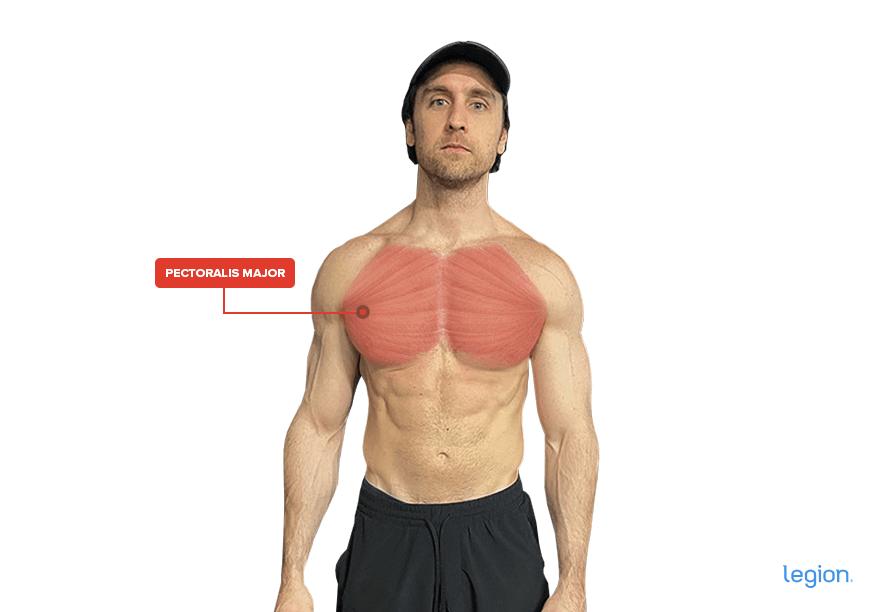[ad_1]
The cable crossover is a chest exercise involving a cable crossover machine.
It’s a staple in bodybuilding chest workouts because it lets you train your chest even when your shoulders and triceps are tired from pressing. Unlike most chest exercises, it also allows you to train your pecs through a full range of motion, which is vital for maximizing growth.
In this article, you’ll learn how to perform the cable crossover with proper form, why it’s beneficial, which muscles it works, common mistakes people make while performing cable crossovers, the best cable crossover alternatives, and more.
How to Do the Cable Crossover
To master proper cable crossover form, split it into three parts: set up, fly, and retract.
1. Set up
Adjust both pulleys on a dual cable or cable crossover machine to shoulder height and attach the single-handle attachments.
Grab a cable handle in each hand and stand centrally between the pulleys so that the cables pull your arms out to your sides. While maintaining a slight bend in your elbows, take 1-to-2 steps forward so your arms are a little behind your torso with your palms facing forward, then adopt a shoulder-width or staggered stance, depending on which feels most stable.
While keeping your chest up, squeeze your shoulder blades together and tuck them down.
2. Fly
While keeping your elbows slightly bent, bring your hands toward each other in an arc, allowing them to cross over each other in front of your chest. If necessary, turn your wrists so your palms face down as your hands cross to prevent the handles from hitting each other.
3. Retract
Reverse the movement and return to the starting position. As your arms retract, maintain a slight bend in your elbows and allow your chest to expand until you feel a stretch in your pecs.
Cable Crossover: Benefits
Here are some of the most notable benefits of the cable crossover exercise:
1. It effectively trains your pecs.
Research shows that the cable crossover activates your pecs to a high degree, which is a solid indication that it’s an effective chest exercise.
Unlike most chest exercises, the crossover also provides constant tension throughout each rep and allows you to change the angle at which you train your pecs more easily. These factors likely contribute to more balanced and complete pec development than if you only did regular, free-weight pressing exercises.
2. It trains your pecs through a full range of motion.
The pecs’ primary function is horizontal adduction, which means they bring your arms across the front of your body.
However, most pec exercises, including the bench press and dumbbell bench press, don’t fully train this movement. In the barbell bench press, your grip on the bar prevents your arms from moving horizontally. Likewise, in the dumbbell bench press, your hands converge at the top of each rep, but don’t cross your body’s midline.
Conversely, cable crossovers require you to move your hands beyond your body’s centerline. This is significant because training your muscles through a full range of motion generally benefits muscle growth.
Cable crossovers don’t allow you to lift as much weight as regular pressing exercises and, as such, aren’t as effective at helping you gain size and strength. Nevertheless, they train your pecs in a way that presses don’t, making them a valuable addition to any hypertrophy training program.
3. It allows you to train your pecs when your shoulders and triceps are tired.
Many weightlifters find that their front delts and triceps are fried after a few sets of bench press, but their pecs could handle a couple more.
The cable crossover allows you to continue training your pecs after your shoulders and arms are tired, ensuring you can train them with the volume (sets) they need to grow and become stronger without your other ”pushing” muscles becoming a limiting factor.
Cable Crossover: Muscles Worked
The main muscles worked during the cable crossover are the pectoralis majors, or “pecs.”
Here’s how they look on your body:

Common Cable Crossover Mistakes
Here are the most common cable crossover mistakes:
1. Pressing the weight.
The problem: People new to the cable crossover often approach it like a barbell or dumbbell bench press, bending their elbows to bring the handles close to the shoulders and straightening their elbows to press the handles away. However, doing so involves other muscle groups, taking emphasis off your pecs.
The fix: Focus on maintaining a slight bend in your elbows throughout each rep. If it helps, visualize hugging a yoga ball as you bring your hands together. This helps you move your hands in an arc and keep your elbows in the correct position.
2. Protracting your shoulder blades.
The problem: Allowing your shoulder blades to spread apart shifts the emphasis from your pecs to your front delts and may put unnecessary stress on your shoulder joint.
The fix: Pinch your shoulder blades together and tuck them down throughout each rep. This stabilizes your shoulder joints and ensures your pecs do most of the work.
3. Using too much weight.
The problem: Trying to lift too much weight can cause your form to break down, reducing the effectiveness of the exercise and increasing the risk of injury.
The fix: Choose a weight that allows you to complete the movement with proper form. The weight should be enough to challenge your muscles but not so heavy that your form suffers. In other words, don’t let your ego get the better of you.
The Best Cable Crossover Alternatives and Variations
Here are the best cable crossover alternatives and variations:
1. Standing Cable Fly
Both standing cable flyes and cable crossovers isolate and deeply stretch the pectoral muscles, which is advantageous for growth.
The only difference between the two exercises is that your hands cross one another during a cable crossover, whereas they only meet in the cable fly.
While this likely means the crossover is slightly better for muscle growth, some prefer the fly because crossing your hands while holding handles can get awkward, especially as the weights get heavy.
2. High-to-Low Cable Crossover
The high-to-low cable crossover may train your lower pecs slightly more than the regular version, making it a viable option for people who want to emphasize their “lower chest.”
3. Low-to-High Cable Crossover
The low-to-high cable crossover is an excellent cable crossover alternative for training the clavicular head of the pecs, also known as the “upper chest.” Training your upper chest is vital for achieving well-rounded and balanced chest development.
4. Dumbbell Fly
The dumbbell fly trains your pecs in a fully stretched position, which research shows is crucial for maximizing growth. It also requires less equipment than the cable crossover, making it a viable alternative, especially if you train at home or while traveling and don’t have access to a cable crossover machine.
5. Pec Deck Machine Fly
The pec deck machine fly probably isn’t as effective at developing your pecs as the cable crossover because your muscles don’t have to work as hard to stabilize the weight. Nevertheless, it’s a workable alternative if you don’t have access to a cable crossover machine, are new to weightlifting, or don’t want to do the cable version.
6. Single-Arm Resistance Band Crossover
The single-arm resistance band crossover is a viable alternative to the cable crossover if you train in a home gym and don’t have access to a cable crossover machine. The only downside is that it provides little resistance when your pecs are stretched, making it suboptimal for muscle growth.
7. Slider Chest Fly
The slider chest fly allows you to perform a movement similar to the cable crossover when you don’t have access to a cable crossover machine. While it’s best to perform it using a pair of gym sliders, you can get similar results with a small towel on a hardwood floor or a paper plate on a carpet.
Who Should Do the Cable Crossover?
The cable crossover is ideal for anyone aiming to build chest muscle for several reasons:
- It allows you to isolate your pectoral muscles, which means you can train them with the volume they need to grow without other muscle groups becoming the limiting factor.
- It allows you to train your pecs in various positions and through different ranges of motion, which likely enhances muscle growth.
- It gives you a break from heavy pressing, which can help keep training more engaging, fun, and productive.
- It’s easier on the joints than heavy pressing, which may reduce your risk of injury.
Sets and Reps for the Cable Crossover
Because of the balance and whole-body stabilisation involved, cable crossovers don’t lend themselves to lifting heavy weights.
As such, it’s best to train in a higher rep range—3 sets of 8-to-10 or 10-to-12 reps at the end of a chest, push, or upper-body workout works well for most people.
+ Scientific References
- Schanke, Whitnee. “Electromyographical Analysis of the Pectoralis Major Muscle during Various Chest Exercises.” Minds.wisconsin.edu, 1 Dec. 2012, minds.wisconsin.edu/handle/1793/62857.
- Barakat, Christopher, et al. “The Effects of Varying Glenohumeral Joint Angle on Acute Volume Load, Muscle Activation, Swelling, and Echo-Intensity on the Biceps Brachii in Resistance-Trained Individuals.” Sports, vol. 7, no. 9, 4 Sept. 2019, p. 204, https://doi.org/10.3390/sports7090204.
- Costa, Bruna Daniella de Vasconcelos, et al. “Does Performing Different Resistance Exercises for the Same Muscle Group Induce Non-Homogeneous Hypertrophy?” International Journal of Sports Medicine, vol. 42, no. 09, 13 Jan. 2021, pp. 803–811, https://doi.org/10.1055/a-1308-3674.
- Schütz, Pascal, et al. “Chest Exercises: Movement and Loading of Shoulder, Elbow and Wrist Joints.” Sports, vol. 10, no. 2, 31 Jan. 2022, p. 19, https://doi.org/10.3390/sports10020019.
- Oranchuk, Dustin J., et al. “Isometric Training and Long-Term Adaptations: Effects of Muscle Length, Intensity, and Intent: A Systematic Review.” Scandinavian Journal of Medicine & Science in Sports, vol. 29, no. 4, 13 Jan. 2019, pp. 484–503, https://doi.org/10.1111/sms.13375.
[ad_2]
Source link



